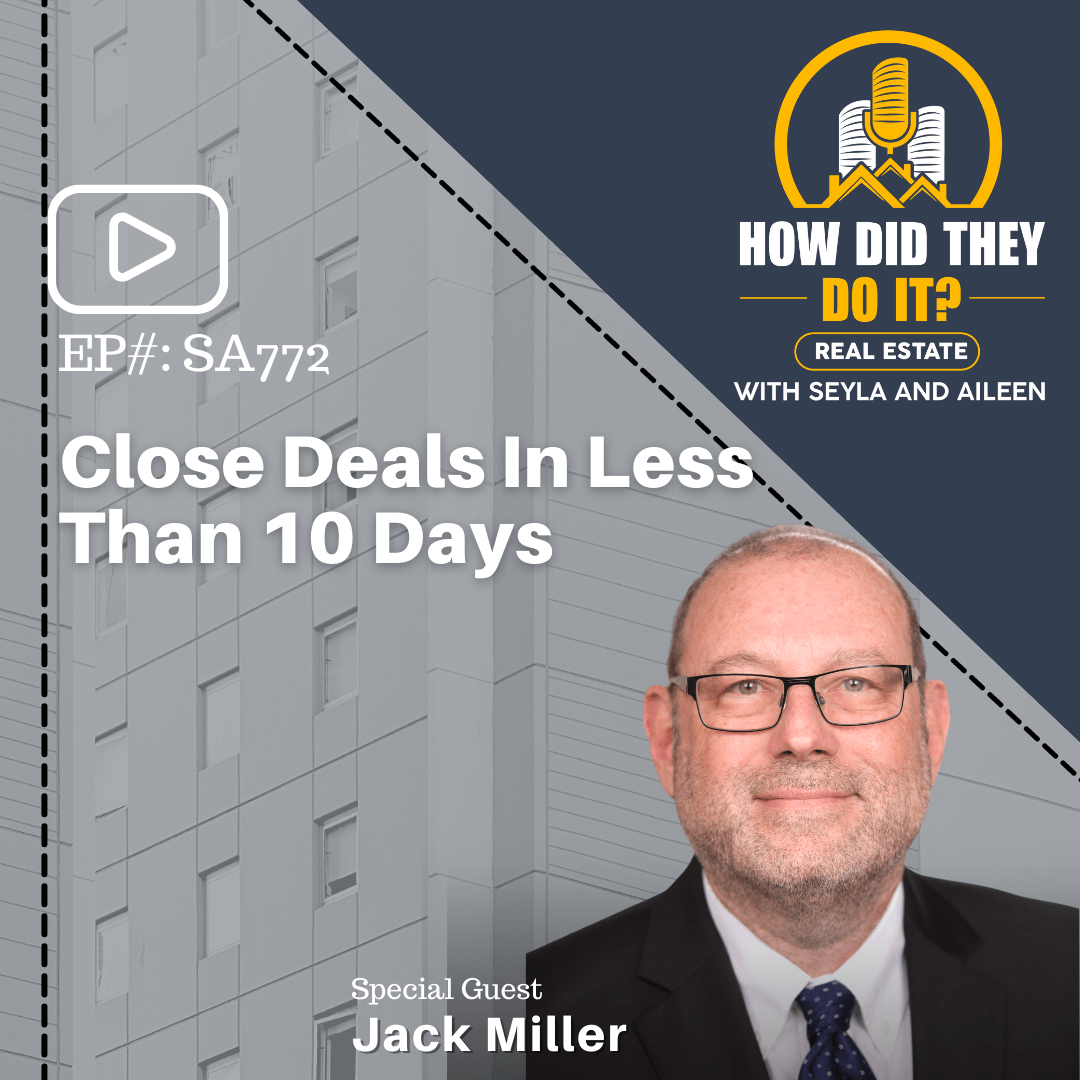Jack Miller and Marcy talk about how to value commercial and investment real estate.
Gelt has been helping commercial real estate and investment borrowers since 1989. When your bank says NO, we say YES!
“Jack: Hey Marcy, so we want to make this video. You know, one of the big things in real estate, probably the biggest thing, is what is… How do we determine or how is value determined on real estate? You know, this is… This is really…
Marcy: I always like to start off at any time anyone asks me, I always say opinion. It’s our opinion because—
Jack: It is opinion, but can I back up, take a couple of steps away? Really, determining value is 99% of the ball game with real estate.
Marcy: Exactly, that’s our direct path to the loan is the value.
Jack: Yeah, so let’s break it down. Let’s try to give people how we determine value. First, let’s do it on single-family home.
Marcy: All right, so how could it be in a single-family home? You know, a lot of people come to us for fix and flips. That’s like the biggest request, or it’s an investment property that’s already leased out. So, when I typically determine the value, I will research it on the internet and see what’s going on. I’ll look at sales in the area, I’ll look at what it’s being rented per square footage, and of course, what is being sold per square footage. But we typically look at even the value on a house to see how much rent it can bring in, and then we’ll figure out what the expenses are on it, the taxes, the insurance, or if there’s a little maintenance. And then we’ll figure out what we call an NOI, even with a single-family home, to determine what the value would be. So…
Jack: So yeah, I agree with that. So let me break it down.
Marcy: so just a little bit of mine but Jack has his own way too.
Jack: Let me break it down a little bit differently. So single-family home, remember, we’re investment lenders, so we look at it from an investment perspective. But if you’re looking at a home to live in, okay, I want to start sort of there and sort of break it down. You can tell everyone watching this is very well rehearsed, and you know, we went through this a million times that we haven’t done that. We’re really just fudging our way through it. So, on a single-family home, you know, you have to look at the property, you have to look at the comps, as Marcy said, very important, look at the square footage and the condition. You know, I speak to people, and I’m pretty sure you do all the time. They’ll say the value is X, and then when you start to look at the comps, it’s a lot smaller than the comparable. So, you have to come up with a price per square footage, then you have to add in the improvements. If this is fully improved, if it’s in beautiful condition, if it’s newer, or if it’s an old junker, there’s a difference per square foot. So, you have to add that in. You know, ultimately, a value is what a ready, willing, and able buyer will pay for it. And you know, we’re making this today in September, as rates are going up. And what’s been happening is just because, people get still having their mindset that values always go up, but values don’t always go up sometimes…
Marcy: It actually starts going down.
Jack: Yeah, I was going to say sometimes values stay the same, sometimes values come down. So be aware, and we’re really making this to the buyer or the real… Really, the real estate investor is our client. Be aware that just because a property sold for, I’m going to say 200 dollars a square foot, doesn’t mean it’s worth that now because now we’re in an increasing interest rate environment, which will push values down. But value is ultimately an opinion. It’s what a ready, willing, and able buyer will pay for it. Also, be very careful of comparables. You know, what’s happened the past five, six years, there’s a lot of comparables out there who are what I call sham comparables. What people are doing sometimes is they’re making up comparables. They’re buying a home, they’re selling it to an LLC that they control to puff up a value, so…
Marcy: It’s not real life.
Jack: It’s not real life. So be very careful. Again, you’ve got to look at what they’re selling for in the area. You’ve got to look at—
Marcy: And also, we tell this all the time to our borrowers, that you do your due diligence. You know, before you’re purchasing something, make sure you’re checking out, you know, the comps, looking around. I mean, don’t take the word of one seller’s sales price.
Jack: That’s a good point. Don’t depend on, you know, a lot of times people call up and say they say, “I got a BPO or an appraisal.” No offense, the guy who’s doing the BPO or the gal who’s doing the BPO has his or her self-interest in mind. They couldn’t care about you. Less about you, the person who’s doing the appraisal. I’ll give them one credit ahead, but they’re doing a fee for a fee, so they don’t really care about you. You need to know more than the guy or gal doing the BPO and the appraisal. So, look at the price per square foot. Look at the condition.
Marcy: And see also what the rents are in the area.
Jack: Yes, so the next step is, let’s deal with that because there’s a difference between coming up with the value to living…
Marcy: Versus an investment.
Jack: Now, we deal with the investment side. So okay on the investment side, how do we value, now, now going with your…
Marcy: Well, typically when I value, I’m still going to use a single-family home for investment. I’m going to figure out what the rents are in the area and what it could be rented for. If you come to me and that property is vacant, I’m going to do more of, like, in my mind, to perform on what it will be rented for, what the expenses are, and what kind of loan the property can carry. Okay, so there’s three things: figuring out the value, figuring out what the rent will be, and figuring out what kind of loan the property can carry. Because we like all our properties to be able to carry our payment, so we call it a debt service, so that the property can withstand our loan and that the borrower doesn’t have to, like, dig into their pockets monthly to make payment, because then it doesn’t make sense for anyone. And we’ll come up with a value, and then a little bit of that comes into play, too, when, you know, someone comes to me and they say, “Oh, I got a great price on this property. I got it for this amount, but it’s really worth that amount.” And again, we typically go with what the market is speaking, and the market speaks for what someone will pay for a property. So that’s how I do it.
Jack: You’re a wealth of knowledge. Yes, so again, you take on investment, you take the income and the fair market income. Just because someone has a tenant in there that’s paying 2 grand a month doesn’t mean that’s the fair market income…
Marcy: It could be 3,000.
Jack: …or it could be 1,500. Don’t be—you know, a lot of people, when they go to sell properties, they put into any bozos, yeah, and puff up the rent to say, “Oh, it’s renting out for two grand a month,” and the fair market value really is 1,500. So come up with a fair market value, add a realistic vacancy. Don’t assume that every tenant is going to pay you every month. You’re always going to have vacancies or evictions. It could be a physical vacancy or an economic vacancy, but factor that in. Factor in the expenses, the real estate taxes, the insurance…
Marcy: And maintenance.
Jack: Yeah, a lot of people don’t realize that in some counties, real estate taxes…
Marcy: It’s so expensive, and it and it doesn’t make sense.
Jack: And they go up at time of sale. So, figure—
Marcy: And also, one more thing, this is really important. I’ve noticed, and I just actually looked at a deal yesterday, that the property was for sale. It was a sale, and I—you know, I always look up, like, when the last time it was sold, and it was sold a year ago for less money, and the information was exactly the same. What it was a year ago, I’m talking about the rent roll, the NOI that was given to me to look at the deal. So, my point is that whoever bought this property, obviously, it wasn’t what they thought they were going to get because they put it on the market a year later with the same numbers and nothing changed. So, my point is, when you’re looking at properties and you’re getting information, if you’re getting a rent roll, an NOI, or whatever the case may be, look at the history of the property, really know when it was bought, when it was sold, and what was going on. Because if you don’t do your due diligence, you could be buying a property that was really not successful.
Jack: What I would advise is, we made a fantastic video on it.
Marcy: He remembers all our videos. I don’t.
Jack: I do. I do. I can’t help it. A great video on debt service coverage and how to figure out, mathematically, the value. You know, we’re talking abstractly, but really, you need to use a spreadsheet and put the numbers in. And numbers don’t lie. And once you put the numbers in…
Marcy: They don’t, they will not make sense.
Jack: Yeah, it’ll come up with the value. So, I would encourage everyone to get that video. It’s called a debt service coverage video, how to calculate it and come up with it. And use that. But you’re right, or so come up with the expenses. Again, back to the expenses. Use a fair market rent, real vacancy, economic or physical vacancy, use them both. Use, you know, what the expenses really are going to be. Don’t—you don’t…
Marcy: Don’t take the seller’s word for it, especially like with taxes. Look up the taxes yourself. You know, there’s—there’s a couple of, like, there was one deal we did where the taxes were, like, killed the deal. I mean…
Jack: It happens all the time. Also use realistic numbers on repairs and maintenance. You know, don’t use low numbers. You know, the reality is it’s always more. The reality is it costs a fortune to replace an HVAC unit or a kitchen or whatever. And just because someone says, “Oh, the roof is new” or “the roof is good” or this and that, first of all, don’t believe them. Most of them are full of it. And, you know, but use a realistic number. And at the bottom of it, you’ll come up with an NOI. And use the NOI. Use an appropriate cap rate. And that’s how you’ll determine a value on a single family. Okay, now what about—let’s move on to, you know, strip centers, multi-families, more interesting properties.
Marcy: So with the strip center it’s actually you have a lot of information which is nice—
Jack: We’re talking about values on let’s say the strip centers or a multi— let’s say a 20-year apartment building or a flex space.
Marcy: Absolutely, and those are actually really fun to figure out the value.
Jack: Get our spreadsheet. I’m telling you—
Marcy: Yeah, we have it on our submission form, and it’s the last tab, and it’s amazing. So, you put all the information, and it calculates…
Jack: It’ll calculate the value. And again, I made—I think there’s two videos on DSCRs and values, using a mathematical formula. Coming up with a value should not be abstract. It should be, “Oh, I like this property. I like—it’s red or it’s blue.”
Marcy: But it’s always goes to Jack that it’s still our opinion.
Jack: It’s opinion. Everything is opinion.
Marcy: Even the appraisal is his opinion. So, you know, we just—we use it to guide us. We guide ourselves with the spreadsheet. So, meanwhile, with a shopping center or an apartment complex, multi-family, whatever the case might be, you know what you get that rent roll…
Jack: Look at the comps. How is it important to look at comparables? So, so important.
Marcy: But still get the information. Get the rent roll, get the expenses on the property. If there’s a management company, you know every expense. And then look what’s going on in the market around that particular cloud. Our rents going up, our rents coming down, and today you can tell. You can see it. Yeah, it will be everywhere.
Jack: And today, because almost everything is online and public information on the internet, it’s so easy to come up with the value and comparables. You know, I was joking around with someone the other day. It was actually a social event. And…
Marcy: You were in social? What?
Jack: My wife forces me every once in a while. I—I’m always…
Marcy: This is as social as he gets, talking to me.
Jack: I’m always social. Once a year, this is the once a year she forced me to go to this social bit. I run into this guy…
Marcy: And I’m so social.
Jack: Yes, I know. I’m anti-social. But the guy says to me, you know, whatever, we’re talking, what do you do? ” How do you lend money outside of Florida?” and I told this guy, I said, “here’s a challenge for you” I said, “come up with a property, any state, any city, tell me what type of properties, tell me if it’s a retail, Class B, Class C, what city, what state.” I said, “I’ll come up with a value without having any leases, any income and expense, no documents.” It’s the truth because we do so many of those.
Marcy: Very clever, man.
Jack: No, am I right?
Marcy: No, you’re right. I—I literally, like, I couldn’t come up with anything. I could read an email that a broker sent to me within three sentences because I’d be like, “Pass,” or “This is good. It makes sense.”
Jack: Think about it. Let’s take a strip center. Let’s take a 20,000 square foot strip center…
Marcy: No, what’s the vacancy? Is it 100% or 80%?
Jack: I’m going to figure 10% or 15% vacancy, okay? I’m going to figure the CAM is going to be depending on if it’s a Northeast state…
Marcy: Define CAM for our audience.
Jack: Oh, we did a video on that too, by the way. Common Area Maintenance. If it’s a Northeast state, you have snow removal that adds a lot to it…
Marcy: Snow. There’s a lot of snow. I’m from Florida, but wow…
Jack: So, depending on the location, I can come up with a CAM, literally in my head. And you can, too, by the way. If I can do it, you can do it. You can come up with the CAM. You can come up with the expenses. You can come up with the rent…
Marcy: Honestly, we keep telling you, overcompensate for the expenses.
Jack: And you can come up with the cap rate. And boom, you can do it.
Marcy: And there’s the value.
Jack: And again, we made another video on this. We’re making another one because values are critical. And you know what? Everyone thinks you make a ton of money in real estate. And the truth is, you can make a ton of money mostly…
Marcy: But you have to be smart about that.
Jack: But you can also lose a lot of money. I joined this…
Marcy: Is this another social thing you did?
Jack: No, no, no, no. I’m not joining any groups. Are you kidding me? No. I was going to give the name about it, but it’s a place where real estate investors post a blogs, and they post just different questions and things like that. I just joined it. I wanted to see what was out there. And I posted a few things, just for that. Good, and you know what? I learned. A lot of these people are taking courses. How to buy money, how to get into real estate with no money down. And you know, a good amount of them are successful. But the reality is, the past ten years, the economy has made every single one successful. But you know what? A lot of people are getting their heads handed to them on a plate right now. They’re losing a fortune because they don’t know what they’re doing because they’re not listening to our videos. They should go through the whole video.
Marcy: We do have people out there that do listen, do watch it…
Jack: A lot of people.
Marcy: I get calls every day. Thank you for the information, blah blah blah.
Jack: So going back to values…
Marcy: Values, we were discussing the values on shopping centers, multi-family, you know…
Jack: Oh, so follow the math, do it. Come up with the bottom line and be conservative. But the bottom line is, don’t just say. We hear this all the time from realtors, investors. Oh, a borrower called and said, “Oh, realtor told me it’s worth 2 million,” or they got a BPO at 2 million. That means nothing. Dig into the details. Every line item. And you should mathematically come up with the formula that says what that value is. That’s the bottom line.
Marcy: It’s all about the numbers. The numbers don’t lie. And reality is, you know, on paper…
Jack: So the short answer. We’re dragging in and going into all kinds—
Jack: Which is like on tangents today.
Jack: Yes, on tangents today. What was I going to say? Oh, the short answer is don’t come up with a value as an arbitrary number. Back into it using solid facts, numbers, and mathematical formulas. You know, mathematical formula…
Marcy: And we just tell you this, and honestly, I know that like most of the brokers I deal with on a daily basis and borrowers, we’re not saying no to say no. We’re saying no because, in a sense, I feel like we’re helping you out by saying no sometimes. Because we’re telling you that, that’s not a good business decision. Again, this is just our opinion. I always need to say that because we—it’s just how we look at things. What would we use now…
Jack: When we lend borrowers money, we’re becoming their partners.
Marcy: Right, so we want to be in a good business deal.
Jack: If we say no to them sometimes, we’re saving their backsides.
Marcy: We are. We’re looking out for you because it doesn’t make sense.
Jack: Bottom line, don’t believe appraisers, don’t believe BPOs. Do your own math. And don’t assume just because properties and rents have been going up that they will go up.
Marcy: Keep going up.
Jack: Keep going up. Maybe they will, maybe they won’t. And a lot of it has to do with your time horizon. What else do we leave?
Marcy: I think it’s good. I think this was a good conversation…
Jack: Yeah, we shot our way through it.
Marcy: We get through it.
Jack: Yeah, I think you did a very good job, Marcy Berger.
Marcy: Alright, that’s what we got for today.
Jack: Oh, I remember. I got to give a pitch.
Marcy: Oh, like our YouTube videos.
Jack: Let me tell you something. If we don’t do loans, we’re not going to be making these videos. So, like our YouTube videos, like our channel, ask questions. We always answer the questions.
Marcy: And we always pick up the phone when we can, and I’ll call you back.
Jack: Yes, remember, we are non-bank lenders, private lenders. Our line is “When your bank says no, we say yes”. People are coming to us for usually one of two reasons. Oh yeah, our thing up there. Oh yeah, right there, right there (points at advertising poster). People are usually coming to us for one of two reasons; either they need to close quick— oh, we just had a payoff of a deal. He bought a—I’m going to say a 70,000 square foot…
Marcy: Beauty shopping center.
Jack: Oh, I’m not talking about that one in Toledo. I don’t want to mention the guy’s name. Yeah, oh, he bought it for—I’m going to say two and a half million. We lent him, I don’t know, 1.6 million. And he just paid us off last week. He got bank financing, but he needed us to close. He was thrilled. The other 50% of them, you know, maybe it’s a foreclosure bailout, maybe they don’t verify their income, there’s a reason they can’t, credit scores low, or they need—they don’t want to deal with banks. A lot of people just don’t want to deal with banks. And, by the way, banks right now are getting tougher.
Marcy: It’s like the conditions on getting a commercial loan through a bank. It’s becoming impossible, and their rates. Their rates have gone up where our rates aren’t looking so bad anymore. Our rates are like in the market, so…
Jack: Okay, our rates were never bad, they’re just adjusted.
Marcy: Yeah, well, they’re just, you know, a little higher than bank rates.
Jack: Of course, they’re higher because they’re getting the service. A bank takes 3 or 4 months to get closing, and we get them closing in a week.
Marcy: As soon as I have the title, that’s it. We’re trying to say goodbye.
Jack: Oh, so remember, if you need non-bank financing, private lender, we also do note-on-note financing. We just made another video on how we lent money on an LP or a GP interest. Anything real estate-related investments, call Marcy at 561-221-0900. Check us out at geltfinancial.com. Most important, most important, have a fantastic day. Okay, life is flying by, and I want everyone to enjoy the day. And, oh, check out our other videos. Use the map, because you know what…
Marcy: This is never going to end.
Jack: You know why? You don’t remember, because I remember.
Marcy: I don’t. I remember.
Jack: I did it. I forget. It was one holiday I was home, and I took the spreadsheet and I did it line by line.
Marcy: I was not there.
Jack: No, you weren’t. You weren’t. I’m sorry. I’m sorry. Okay, have a great day, everyone. Take care.
Marcy: Bye.”
Category: Borrowers
























